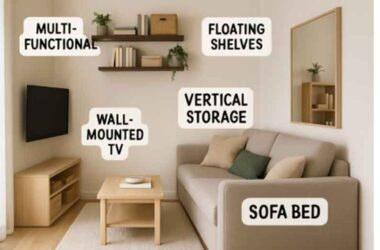Home renovations often focus heavily on the interiors, with homeowners investing in updated kitchens, modern bathrooms, and fresh paint. However, the outdoor space plays a major role in a property’s overall appeal and functionality. Landscaping can transform the way a home feels and even increase its market value, but only if it is approached with careful planning.
Many homeowners unknowingly make mistakes during landscaping that not only cost money but also diminish the beauty of their outdoor spaces. Understanding these common missteps can help you create a landscape that complements your home and provides lasting enjoyment.
Ignoring a Comprehensive Plan
One of the biggest mistakes homeowners make during landscaping is diving in without a plan. Planting trees, shrubs, and flowers randomly might feel spontaneous, but it often leads to a disorganized appearance. Landscaping is a long-term investment that requires foresight regarding plant growth, maintenance needs, and seasonal changes.
A clear plan should consider the size and shape of the property, sunlight and shade patterns, and the functional areas you want to create. Whether you envision a seating space, a children’s play area, or a garden path, having a blueprint ensures that every element fits harmoniously into the overall design. Neglecting to plan can lead to overcrowded plants, unbalanced layouts, and costly rework later.
Choosing Plants That Are Unsuitable for Your Climate
Many homeowners are tempted by exotic plants or colorful flowers they see online or at local nurseries. However, plants that are not suitable for the local climate will struggle to thrive. This mistake often leads to wasted money and effort as plants wither or fail to grow as expected.
Choosing native or climate-adapted species is always a smarter move. Native plants require less water, are resistant to local pests, and blend naturally with the environment. For instance, drought-tolerant plants are ideal for regions prone to water restrictions, while moisture-loving varieties suit rainy areas. Researching plant requirements before purchasing them saves frustration and promotes a healthy, sustainable landscape.
Overlooking Soil Preparation
Healthy landscaping begins with healthy soil. Many homeowners plant grass or shrubs without understanding the condition of their soil. Poor-quality or compacted soil can stunt plant growth, even if you choose the right species. This mistake is particularly common in newly constructed homes where topsoil is often stripped during construction.
Testing soil for pH levels and nutrient content is an essential first step. Adding compost, organic matter, or soil conditioners can drastically improve the success of your landscaping. By preparing the soil properly, you create a foundation that supports vibrant, long-lasting plant growth.
Planting Trees Too Close to Structures
Large trees add beauty, shade, and privacy to any property, but their placement requires careful consideration. Planting trees too close to a home, fence, or driveway can cause significant problems as they mature. Roots may disrupt foundations and pathways, while branches can damage roofs or block sunlight.
When planning tree placement, consider the tree’s expected height and root spread over time. Leaving ample space around structures ensures safety and prevents costly damage in the future. Remember, a sapling may seem harmless now, but in 10 or 20 years, it could become a major issue.
Forgetting About Proper Drainage
Poor drainage is a landscaping issue that can lead to serious problems like water pooling, erosion, and damage to plant roots. Homeowners often overlook grading or slope when redesigning their yards, which results in standing water after rainstorms.
Before starting any landscaping project, evaluate how water flows across the property. Installing French drains, creating swales, or adding permeable surfaces can improve drainage. Proper planning ensures that water flows away from the house and garden beds, keeping the landscape healthy and functional.
Neglecting Maintenance Requirements
A beautiful landscape is not a one-time effort. Many homeowners underestimate the maintenance needs of their chosen plants and features. High-maintenance plants, sprawling lawns, and elaborate garden beds can become overwhelming without regular care.
Selecting low-maintenance plants and incorporating features like mulched beds can reduce upkeep. Additionally, installing an irrigation system helps ensure consistent watering, making it easier to maintain a lush yard without constant manual effort. A realistic approach to maintenance saves time, money, and stress in the long run.
Ignoring the Importance of Outdoor Functionality
Landscaping should be about more than aesthetics. A common mistake in home renovations is focusing solely on visual appeal without considering functionality. For example, a yard filled entirely with decorative plants may leave no space for outdoor activities, entertaining, or simple relaxation.
Design your landscape with usability in mind. Paths, patios, seating areas, and shaded spots can enhance your quality of life. Consider how you and your family will use the outdoor space on a daily basis, and balance aesthetics with practicality.
Skipping Professional Guidance
Many homeowners attempt to handle every aspect of landscaping themselves, which can sometimes lead to costly mistakes. While DIY efforts can be rewarding, certain elements—like irrigation installation, retaining walls, or large-scale planting—benefit from professional expertise.
Consulting experts like ARC Design Landscape San Diego can provide valuable insights into plant selection, layout, and drainage solutions. Professional guidance ensures your vision is executed efficiently while avoiding common pitfalls that lead to expensive fixes later.
Overloading the Space with Hardscaping
Hardscaping features such as patios, decks, and stone pathways can enhance a landscape, but too much of it can create a cold, unwelcoming appearance. Some homeowners cover large portions of their yard with concrete or pavers, leaving little room for greenery.
Balancing softscape and hardscape elements is key. Plants bring life and color to a space, while hardscape provides structure and usability. Overloading on one or the other disrupts harmony and diminishes the natural feel of an outdoor area.
Ignoring Seasonal Changes and Growth
Landscapes evolve throughout the year, and overlooking seasonal changes can lead to disappointment. A yard that looks beautiful in spring may appear barren in winter if it lacks evergreen plants or year-round interest. Similarly, not accounting for plant growth can result in overcrowded spaces.
Incorporate a mix of plants that bloom in different seasons and maintain visual interest all year. Spacing plants properly and thinking ahead about their mature size ensures your landscape remains attractive without constant reshuffling.
Failing to Budget for the Project
A well-planned landscape requires a clear and realistic budget. Some homeowners start projects impulsively, buying plants and materials without calculating the total cost. This often leads to incomplete projects or lower-quality choices to cut corners.
Budgeting for landscaping should include materials, labor (if using professionals), maintenance tools, and ongoing care. A solid financial plan ensures the project is completed smoothly and meets your long-term goals without unnecessary financial strain.
Conclusion
Landscaping is an integral part of home renovations that can significantly enhance curb appeal and livability. However, common mistakes such as neglecting a plan, choosing the wrong plants, or underestimating maintenance can undermine your efforts. Taking the time to research, prepare, and seek professional guidance where necessary can make the difference between a frustrating project and a thriving outdoor retreat.
By avoiding these mistakes, you can create a landscape that not only beautifies your property but also provides functional and lasting enjoyment for years to come.







